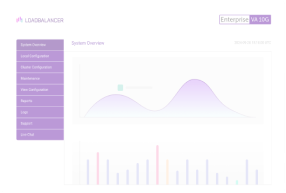Load balancing PowerSchool eSchoolPlus SIS
Benefits of load balancing PowerSchool eSchoolPlus SIS
The top three benefits of implementing load balancing for the PowerSchool eSchoolPlus Student Information System (SIS) are optimized performance, high availability/fault tolerance, and scalability.
- Optimized performance: Load balancing ensures that incoming user traffic (from teachers, administrators, parents, and students) is evenly distributed across multiple application servers. This prevents any single server from becoming overwhelmed, especially during high-traffic periods like grade submission deadlines or report card distribution. By distributing the workload, the system’s overall response time is reduced, leading to a smoother, faster user experience (UX) and less lag. Server resources are used more efficiently, maximizing the throughput of the existing infrastructure.
- High availability and fault tolerance: A load balancer continuously monitors the health of all application servers. If an eSchoolPlus server fails or needs maintenance, the load balancer automatically redirects traffic to the remaining healthy servers, providing a resilient service. The SIS remains available to users even if one or more application servers go offline, which is critical for real-time operations like attendance tracking and grading. This automatic redirection, or failover, prevents service interruption, removing single points of failure.
- Scalability: Load balancing allows districts to easily increase the capacity of their PowerSchool eSchoolPlus environment by simply adding more application servers (often called Tomcat application nodes) to the server pool. As a district grows or as usage of the SIS increases (e.g., more students, more parent portal access), the load balancer can seamlessly incorporate new resources to handle the increased load without performance degradation. It provides the flexibility to scale the infrastructure horizontally to meet future demands for a high-volume application.
About PowerSchool eSchoolPlus SIS
PowerSchool eSchoolPlus SIS is a cloud-based Student Information System (SIS), a software platform used by schools and districts to manage all student data, including grades, attendance, and discipline records. Developed by PowerSchool, it provides tools for administrators, teachers, parents, and students to access and manage this information, aiming to streamline operations and improve communication between home and school.
Why Loadbalancer.org for PowerSchool eSchoolPlus SIS?
Loadbalancer’s intuitive Enterprise Application Delivery Controller (ADC) is also designed to save time and money with a clever, not complex, WebUI.
Easily configure, deploy, manage, and maintain our Enterprise load balancer, reducing complexity and the risk of human error. For a difference you can see in just minutes.
And with WAF and GSLB included straight out-of-the-box, there’s no hidden costs, so the prices you see on our website are fully transparent.
More on what’s possible with Loadbalancer.org.
How to load balance PowerSchool eSchoolPlus SIS
The load balancer can be deployed in four fundamental ways: Layer 4 DR mode, Layer 4 NAT mode, Layer 4 SNAT mode, and Layer 7 Reverse Proxy (Layer 7 SNAT mode).
For eSchoolPlus SIS, Layer 7 Reverse Proxy is recommended.
Virtual service (VIP) requirements
To provide load balancing and HA for PowerSchool eSchoolPlus SIS, a single combined VIP is required:
- eSchool (combined ports to cover all required services).
Load balancing deployment concept

Topology
Layer 7 Reverse Proxy can be deployed using either a one-arm or two-arm configuration. For two-arm deployments, eth1 is typically used for client side connections and eth0 is used for Real Server connections, although this is not mandatory since any interface can be used for any purpose. For more on one and two-arm topology see Topologies & Load Balancing Methods.
About Layer 7 Reverse Proxy load balancing
Layer 7 Reverse Proxy uses a proxy (HAProxy) at the application layer. Inbound requests are terminated on the load balancer and HAProxy generates a new corresponding request to the chosen Real Server. As a result, Layer 7 is typically not as fast as the Layer 4 methods. Layer 7 is typically chosen when either enhanced options such as SSL termination, cookie based persistence, URL rewriting, header insertion/deletion etc. are required, or when the network topology prohibits the use of the Layer 4 methods. The image below shows an example network diagram for this mode.
The image below shows an example Layer 7 Reverse Proxy network diagram:

Because Layer 7 Reverse Proxy is a full proxy, Real Servers in the cluster can be on any accessible network including across the Internet or WAN.
Layer 7 Reverse Proxy is not transparent by default, i.e. the Real Servers will not see the source IP address of the client, they will see the load balancer’s own IP address by default, or any other local appliance IP address if preferred (e.g. the VIP address).
This can be configured per Layer 7 VIP. If required, the load balancer can be configured to provide the actual client IP address to the Real Servers in 2 ways. Either by inserting a header that contains the client’s source IP address, or by modifying the Source Address field of the IP packets and replacing the IP address of the load balancer with the IP address of the client.

















